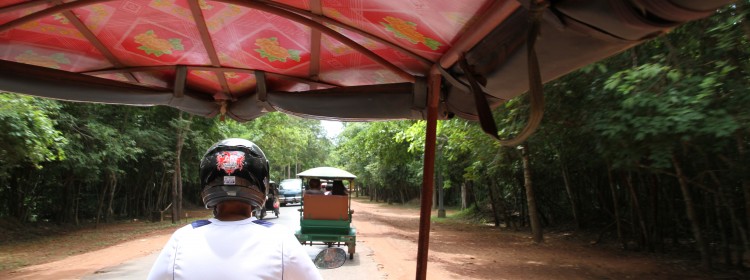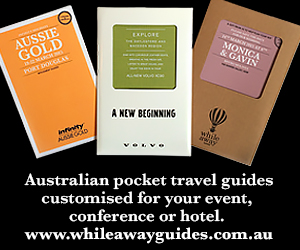Soon after Flavie Thevenet first visited Cambodia from her native France more than 20 years ago, she walked past a family eating lunch outside their home on the outskirts of the capital, Phnom Penh. It was obvious that they were desperately poor, yet the family insisted she share their food, and she accepted.
Flavie, pictured below, reflects on that small act of generosity often. She’s experienced such unconstrained hospitality many times over the years – more than a decade in total – that she’s lived in the southeast Asian nation and in her current role as country manager for the tour operator Khiri Travel.
 Though still poor and relatively underdeveloped, Cambodia has moved on and is recovering well from its nightmarish past, says Flavie, who loves the country. “People here want to move forward,” she says enthusiastically over coffee at a Siem Reap café. “So many have started from absolutely nothing, having been through terrible times in their history, and they’re making real progress, as you can see in the standards of many businesses and hotels.”
Though still poor and relatively underdeveloped, Cambodia has moved on and is recovering well from its nightmarish past, says Flavie, who loves the country. “People here want to move forward,” she says enthusiastically over coffee at a Siem Reap café. “So many have started from absolutely nothing, having been through terrible times in their history, and they’re making real progress, as you can see in the standards of many businesses and hotels.”
Flavie is passionate, too, about responsible tourism, which means that Khiri Travel, which is active in supporting local communities (tagline: people, planet, profit) is proving to be an excellent fit for her.
Typical of the company’s embrace of sustainability is its pledge this year to donate to youth development 2.5% of its revenue from new educational travel group bookings visiting southeast Asia. It also supports Khiri Reach, a charity to help disadvantaged people through community development, conservation and other projects.
Established in 1993, Khiri is headquartered in Bangkok and specialises in tailored inbound tours to Cambodia, Laos, Myanmar, Thailand, Vietnam, Sri Lanka and the Maldives with staff support in each: 14 in the capital Phnom Penh and four in the smaller city of Siem Reap, which is close to the Twelfth-Century Angkor Wat temple complex, below, the largest religious monument in the world.
One of its key offers is incentive experiences – at a wide variety of price points – ranging from community-based tourism and city escapes to country “immersions” throughout Indochina.
 Each incentive trip that Khiri people organise is customised, and many are innovative, Flavie says. They can range from a trip on a private jet to a wedding in a preferred hotel, dinner on a private island, afternoon tea in a royal palace and a private caving expedition in the karst mountains of Vietnam.
Each incentive trip that Khiri people organise is customised, and many are innovative, Flavie says. They can range from a trip on a private jet to a wedding in a preferred hotel, dinner on a private island, afternoon tea in a royal palace and a private caving expedition in the karst mountains of Vietnam.
A great attraction for organisers on strict budgets is that Cambodia is, in the parlance of some experts and enthusiasts, fantastically cheap. As the 1.5 million tourists who visited it last year know, this is reflected in hotel prices. According to the most recent hotels.com index that compares room rates internationally, Cambodia topped the list of cheapest hotel destinations for Aussie travellers in 2014, at an average nightly rate of AUD73, followed by Vietnam at AUD91 and Thailand at AUD113.
“The potential for incentives is wonderful here because as a MICE destination it’s really affordable as well as being authentic,” adds Flavie. “It’s not commercialised, it’s exotic and has great history; what’s more you can feel comfortable in Cambodia, it’s safe and easy to find your way around.”
 Day on the lake
Day on the lake
To experience a Khiri Cambodia adventure first-hand, I accompany Flavie and her colleague Bunseun You, Khiri’s branch manager based in the provincial capital of Siem Reap, on a day trip to “Komphong Khleang” in August. It’s one of several fishing villages set along the shoreline of Tonle Sap Lake, a freshwater system in the 13,000 square kilometre Cambodian floodplain about an hour’s drive from Siem Reap. It’s a hot, sunny day as we set off in a diesel-powered wooden boat to explore the vast lake, whose tea-coloured waters teem with fish.
As we chug along a narrow canal leading to the main body of the lake, we spy fishermen, their heads bobbing in the water, arranging circular nets at regular intervals. As we watch, one small group hauls a glittering catch of several hundred into a canoe.
“They get a lot here; the lake is very productive,” says Bunseun. “It’s one of the richest ecosystems in Asia.”
Soon we pass a floating community, which consists almost entirely of fishing vessels and home-made houseboats kept afloat by oil drums lashed together, moored close to each other. People in these floating villages are mostly Vietnamese, Flavie says. They’ve been living like this for centuries, since they migrated to Cambodia, and their livelihood depends mostly on their proximity to fish – fresh, smoked or salted – which they also sell at markets.
 These villagers seem to do everything on or in the water. Next to one floating home, its deck lined with colourful flowerpots, young kids are diving and swimming. Then we pass by what appears to be a community hall afloat.
These villagers seem to do everything on or in the water. Next to one floating home, its deck lined with colourful flowerpots, young kids are diving and swimming. Then we pass by what appears to be a community hall afloat.
In another houseboat, whose sides are open to catch a cooling breeze, a family is gathered round a table having a meal, and a man is asleep in a hammock. Almost all the vessels have antennas, and most people we pass smile and wave, even though tourists must be a common sight here.
“It’s typical,” says Flavie. “Cambodians are so enthusiastic about sharing their food and customs and hosting visitors. It’s contagious.”
Stilt village
This is demonstrated further after we end our lake cruise and arrive at another small village. At this one, which is land-based, Flavie and Bunseun lead me to the foot of an extraordinary timber dwelling, perched on ten-metre-tall stilts. This is a necessity in the wet season when water levels can rise dramatically. Scores of these spindly homes flank a dusty street, resembling a bizarre lakeside forest.
 The lady of the stilt house greets us shyly, her eyes curious, as we clamber up a steep flight of steps to the first level. Bunseon introduces her to us as Bun Kimheang, his mother-in-law. Bun, pictured in her home, left, bustles about, serving us a simple but delicious Khmer lunch of braised pork, rice and fresh local vegetables, which include yellow pumpkin-like portions, as well as ice-cold Angkor lager.
The lady of the stilt house greets us shyly, her eyes curious, as we clamber up a steep flight of steps to the first level. Bunseon introduces her to us as Bun Kimheang, his mother-in-law. Bun, pictured in her home, left, bustles about, serving us a simple but delicious Khmer lunch of braised pork, rice and fresh local vegetables, which include yellow pumpkin-like portions, as well as ice-cold Angkor lager.
In the wet season the water can lap at the floorboards of these houses, says Bunseon, pictured below, and in such times travel is limited to wooden canoes and makeshift craft in which children paddle to and from school. People on some Khiri tours can actually stay overnight here, Bunseon explains. He shows me a curtained-off section of the next floor up, where mattresses line the floor. It’s minimalist and spotlessly clean.
Flavie, Bunseun and their colleagues pride themselves on being able to introduce visitors to experiences like these, and on their local knowledge. “We know the best restaurants, hotels, and transport companies by heart in Siem Reap and Phnom Penh, and many of our team possess exceptional training,” she says.
“We choose our clients and agents carefully, because our priorities are to meet customers’ expectations while always protecting the destination; we love being in Asia for the right reasons, not only for profit or because it represents a cheaper option.”
 Other Cambodia tour options from Khiri include “Cambodian Island Paradise,” “Exotic Capital, Local Delights,” where visitors can sample Khmer food on a walking tour through the heart of Phnom Penh, and “Banteay Chhmar Tented Camp”.
Other Cambodia tour options from Khiri include “Cambodian Island Paradise,” “Exotic Capital, Local Delights,” where visitors can sample Khmer food on a walking tour through the heart of Phnom Penh, and “Banteay Chhmar Tented Camp”.
The latter involves overnight stays at Khiri’s luxury tented camp surrounded by massive temple ruins in the northwest of the country, a three-and-a-half-hour drive from Siem Reap. This one-night, two-day trip starts from USD422 per person. See the video and get more information here:
Many visitors to Siem Reap aiming to see Angkor Wat also take a drive, an hour by tuktuk or 45 minutes by cab, to the landmine museum. This is a facility started by Aki Ra, a former Khmer Rouge soldier who cleared landmines with a stick and at one stage lived in a house full of ordnance. Today the museum cares for poor children who live on the site.
How much?
Khiri packages for hotels, tour guides, transport and lunch start from around USD60 per person per day, says Flavie. Five-star hotels in Cambodia, like Hyatt, Raffles and so on start from USD150 a night in the low season from about March to October, and good four-star hotels, like the Somadevi, whose pool and gardens are pictured below, in Siem Reap, cost around USD40.
Operators’ advice
Flavie Thevenet: “I recommend that travellers to Cambodia do not limit their exploration to Siem Reap and its temples. Angkor Wat and the majesty of the Khmer Empire are mesmerising, a must-see, but many other historical and scenic places are equally appealing on a smaller scale and without the distraction of huge crowds. By spending time in the countryside, travellers have more opportunity to interact with local people. Hearing their stories is equal parts charming and inspiring.”







